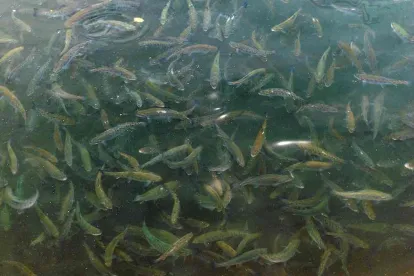FERC Assesses Civil Penalty for Violation of Standard Article 5
In an unprecedented action, the Federal Energy Regulatory Commission (FERC) on April 21, 2022, issued a $600,000 civil penalty to Ampersand Cranberry Lake Hydro, LLC (Ampersand) for failing to retain possession of property associated with the Cranberry Lake Project located in St. Lawrence County, New York. Standard Article 5 of FERC licenses requires the licensee to retain possession of all project property covered by the license, and not to voluntarily dispose of such property without FERC’s approval. This appears to be the first time FERC has assessed a civil penalty for violation of Standard Article 5. In this case, FERC had ordered the licensee to rehabilitate the project’s fuse plug spillway. The licensee was unable to carry out the work because the dam owner, a municipal corporation, evicted Ampersand from the property over a dispute about which one was responsible for the dam remediation. FERC found that the licensee, by entering into a settlement agreement with the dam owner to settle the lease dispute and vacate the property, violated Standard Article 5. Since Ampersand is still the licensee but does not have possession of the dam, it is unclear how the dam safety issue will be resolved.
FERC Releases Equity Action Plan and Highlights Hydropower as a Focus Area
On April 15, 2022, FERC issued an Equity Action Plan (EAP) as part of its goal to promote equity and remove barriers, and better serve consumers in underserved communities. According to FERC Chairman Glick, the plan “is a road map for FERC to build a culture and program that ensures the Commission is appropriately integrating environmental justice and equity issues into our decision making and day-to-day operations.”
The EAP is based on five focus areas:
-
Build the Office of Public Participation
-
Strengthen Tribal Government Consultation and Engagement
-
Ensure Natural Gas Project Certification and Siting Policies and Processes Are Consistent with Environmental Justice
-
Ensure Hydropower Licensing Policies and Processes Are Consistent with Environmental Justice
-
Foster FERC Staff Equity Readiness
In particular to hydropower, the plan notes that FERC received less stakeholder input regarding environmental justice as compared to natural gas certifications, which may be a product of the existing FERC hydropower guidelines on consultation and stakeholder engagement. While the licensing and relicensing processes include Tribal consultation, there is nothing that explicitly addresses environmental justice, however. To remediate this issue, FERC intends to:
-
Review its hydropower licensing policies and processes, including its National Environmental Policy Act (NEPA) implementing regulations;
-
Engage stakeholders by holding public workshops on environmental justice and Tribal issues that arise in the hydropower project review process; and
-
Build staff capacity and educate and train existing staff on environmental justice in the hydropower licensing context.
Interior Reinstates Bureau of Land Management Compensatory Mitigation
The U.S. Department of Interior issued a Solicitor’s Opinion on April 15, 2022 reinstating a December 21, 2016 Obama Administration Solicitor’s Opinion which affirmed that the Federal Land Policy and Management Act (FLPMA) provides the Secretary and the Bureau of Land Management with authority to identify and require appropriate mitigation in connection with issuance of FLPMA permits to occupy federal lands. According to the reinstated opinion, mitigation may consist of compensatory mitigation on either public lands or private lands having a connection to resources on public lands—regardless of their geographic proximity with public lands—so long as such mitigation on private lands occurs with the consent of the property owner. Compensatory mitigation, or off-site mitigation, may provide added flexibility when a project development has environmental impacts that cannot cost-effectively be mitigated onsite.
Biden Administration Walks Back Key Trump Era NEPA Regulation Changes
On April 20, 2022, the Council on Environmental Quality (CEQ) published a final rule reversing strategic changes made under the Trump Administration to CEQ regulations implementing NEPA (Final Rule). The Final Rule will be effective May 20, 2022.
The Final Rule largely follows the changes outlined in CEQ’s October 7, 2021, Proposed Rule, restoring three key provisions to the prior regulations: (1) considerations relevant to the “purpose and need” of a proposed action; (2) the definition of “effects,” restoring the prior definitions of direct, indirect, and cumulative effects; and (3) agency flexibility to develop NEPA implementation procedures that go beyond the government-wide NEPA regulations. CEQ states that it intends the provisions in this Final Rule to have the same meaning as the corresponding provisions in the regulations in effect prior to the Trump Administration’s 2020 “Update to the Regulations Implementing the Procedural Provisions of NEPA” (2020 Rule).
This Final Rule completes the first of a two-phased process by the Biden Administration to reconsider and revise the 2020 Rule. Phase 2, expected in 2022, will take a more comprehensive review of the NEPA regulations.
Overview of Phase 1
The Phase 1 Final Rule includes a narrow set of changes intended to reverse several of the most controversial elements of the 2020 Rule, as highlighted below.
Purpose and Need. The Final Rule (1) eliminates language added by the 2020 Rule requiring agencies to base the “purpose and need” of a proposed action on the goals of the applicant and the agency’s authority, and (2) makes a conforming change to the definition of “reasonable alternatives.” The purpose and need section of an environmental impact statement (EIS) explains why a proposed action is being pursued and provides the boundaries for the range of reasonable alternatives considered. In reverting to the pre-2020 Rule purpose and need language, CEQ states that it is eliminating ambiguity that could be interpreted to make the applicant’s goals and the agency’s statutory authority the only factors that agencies can consider when developing a purpose and need statement for environmental review of an application for an agency authorization. This change will potentially result in more expansive purpose and need statements, or reinvigorate litigation challenging purpose and need statements that prioritize an applicant’s goals over other potentially relevant factors.
Definition of “Effects” or “Impacts.” NEPA requires agencies, in undertaking environmental reviews of covered actions, to assess the environmental effects of the proposed action, alternatives, and any adverse environmental effects that cannot be avoided if the proposed action is implemented. The Final Rule restores the concepts of direct, indirect, and cumulative impacts. CEQ explains that these changes are necessary to “help ensure the proper scope of analysis that NEPA requires, including analysis of effects on climate change, communities with environmental justice concerns, and wildlife.”
The 2020 Rule eliminated long-used concepts of direct, indirect, and cumulative effects, instead focusing the analysis on those effects that are reasonably foreseeable and that have a reasonably close causal relationship to the proposed action or alternatives. The 2020 Rule further provided that a “but for” causal relationship is not sufficient, and that effects generally should not be considered “if they are remote in time, geographically remote, or the product of a lengthy causal chain.” Although the Final Rule undoes the 2020 Rule changes to the definition of “effects or impacts” by restoring direct, indirect, and cumulative effects as part of the definition of “effects,” the Final Rule recognizes that nothing in the CEQ regulations requires agencies to categorize effects separately as direct, indirect, or cumulative. Rather, CEQ states that agencies can holistically discuss “all reasonably foreseeable direct, indirect, and cumulative effects, rather than delineating the categories in separate sections of a NEPA document.”
In the preamble to the Final Rule, CEQ explains that the revised definition of effects ensures that NEPA reviews consider adverse and beneficial effects, including greenhouse gas emissions, over various timeframes. Thus, according to CEQ, air pollution like greenhouse gas emissions released by fossil fuel combustion is often a reasonably foreseeable indirect effect of proposed fossil fuel extraction that agencies should evaluate in the NEPA process, even if the pollution is remote in time or geographically remote from a proposed action. The consideration of beneficial effects is of particular relevance to renewable energy project development and carbon capture and storage projects. Using the example of a utility-scale solar facility, CEQ notes that a solar facility could have short-term direct effects (such as adverse construction and land impacts), as well as long-term indirect beneficial effects (such as reductions in air pollution from the renewable energy generated at the facility that displaces more greenhouse gas intensive energy sources like coal or natural gas).
Agency NEPA Procedures. The Final Rule implements the changes proposed in the Proposed Rule to remove limitations imposed by the 2020 Rule on the scope of agency-specific NEPA procedures and to clarify that while agency NEPA procedures must be consistent with the CEQ regulations, agencies also have the discretion and flexibility to develop procedures that go beyond the CEQ regulatory requirements. This revision will allow agencies to adopt procedures that may go beyond the CEQ regulations as appropriate to address their individual authorities, programs, and circumstances.
Potential Impacts
The Phase 1 revisions return the regulations to the pre-Trump Administration status quo in the three areas addressed by the rule. The short time period in which the 2020 Rule will have been in effect means that few NEPA analyses were conducted under that rule.
The Final Rule’s focus on restoring consideration of indirect and cumulative impacts could result in agencies giving greater consideration to climate change and environmental justice-related impacts. For renewable energy, like hydropower, the return to the previous effects definition and consideration of beneficial impacts will be important in future NEPA reviews.
Although FERC as an independent agency is not bound to follow CEQ’s rules, it generally does so unless it determines they are inconsistent with its own statutory responsibilities. Other federal agencies with concurrent permitting authority over hydropower development, such as federal land management agencies and the U.S. Army Corps of Engineers, will be bound to follow the new CEQ rules.
With the Phase 1 Final Rule now complete, CEQ will continue to work on Phase 2, which CEQ has said will comprehensively consider the 2020 Rule and the NEPA regulations. Statements in the preamble to the Final Rule suggest that CEQ may use Phase 2 of the rulemaking or additional guidance documents to provide greater clarity on analyses of greenhouse gas emissions, climate change, and environmental justice.
Independent Forensic Team Issues Final Report on Michigan Dam Failures
The Independent Forensic Team (IFT) contracted by FERC to develop findings and opinions on the May 19, 2020 failures of the Edenville and Sanford Dams issued its final report on May 4, 2022. Failure of the Edenville Dam resulted in the overtopping and cascading failure of the downstream Sanford Dam. The report concluded that the physical mechanism of the Edenville Dam failure was static liquefaction, or sudden loss of soil strength, in a section of the embankment due to a record high lake level caused by the combination of high rainfall and unusually impervious ground conditions. The report found that the 1920s era Edenville Dam was constructed in a manner which significantly deviated from the design plans and specifications, resulting in the embankment being constructed with sections of loose sands. The IFT concluded the dam failure, although unforeseen by anyone, was preventable, but refused to attribute it to any one individual, group, or organization. Rather, the IFT found that the overall system for financing, designing, constructing, operating, evaluating, and upgrading the dams fell short of assuring dam safety. The report does point out that by revoking the Edenville license, FERC deprived the licensee of funds necessary to improve the Edenville spillway and eliminated the option of releasing water through the powerhouse, both of which could have prevented the embankment instability failure. The IFT report recommends in future not relying entirely on physical inspections to identify dam safety risks, but to include periodic comprehensive reviews of original design and construction, performance, operations, analyses of record, maintenance, and repairs. The report notes that the Michigan dam failures reinforce the lessons learned from the Oroville Dam spillway incident forensic investigation, as well as FERC’s recently promulgated rule changes to its Part 12 dam safety program in response to that incident. The IFT further recommends that all dam safety regulatory agencies, including FERC, have the authority to order a dam breach if dam safety risks are judged to be unacceptable and an owner does not have the financial resources to reduce the risks or does not comply with a dam safety directive. The report does not, however, address the potential environmental and social impacts of such a course of action, or how to reconcile it with the dam owner’s statutory rights under the Federal Power Act in the case of FERC-licensed dams.






 />i
/>i

